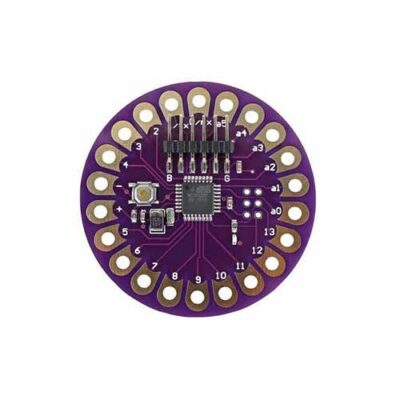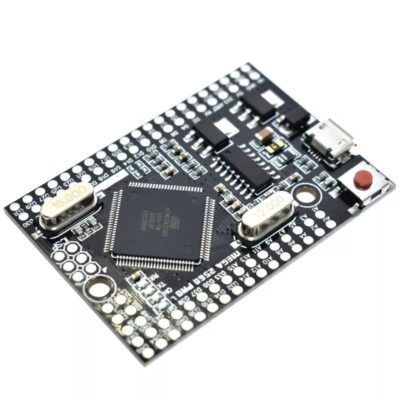Categories: Arduino
Arduino Lilypad
Rated 0 out of 5
0 Reviews
The LilyPad Arduino Main Board is based on the ATmega168V (the low-power version of the ATmega168) or the ATmega328V.
The LilyPad Arduino Main Board is based on the ATmega168V (the low-power version of the ATmega168) or the ATmega328V.
Categories: Arduino
Arduino Mega 2560
Rated 0 out of 5
0 Reviews
First, we have to mention that-, this is the low-cost Chinese version of Arduino Mega 2560 R3 from China with the same feature, pinout diagram, and board size.But, if you are only the quality concern people, then please check the genuine version of Arduino Mega 2560 R3 from SparkFun, USA. This high-quality PCB Board and all of the genuine components give you a quality performance.The Arduino mega price in bd of a Chinese version is about 4 to 5 times lower than that of the genuine copy
First, we have to mention that-, this is the low-cost Chinese version of Arduino Mega 2560 R3 from China with the same feature, pinout diagram, and board size.But, if you are only the quality concern people, then please check the genuine version of Arduino Mega 2560 R3 from SparkFun, USA. This high-quality PCB Board and all of the genuine components give you a quality performance.The Arduino mega price in bd of a Chinese version is about 4 to 5 times lower than that of the genuine copy
Categories: Arduino
Arduino Mega 2560 PRO MINI
Rated 0 out of 5
0 Reviews
Specifications:
- Microcontroller: ATmega 2560 (16MHz)
- Interface: USB-UART-CH340G (12MHz)
- Input voltage: 6-9V (Peack @18V)
- Output current: 800mA/5V and 800mA/3.3V
- Connection: PC-Micro USB
- 70 Digital I/Os
- 16 Analog entries
- 14 PWM
- 4 UART bus
Specifications:
- Microcontroller: ATmega 2560 (16MHz)
- Interface: USB-UART-CH340G (12MHz)
- Input voltage: 6-9V (Peack @18V)
- Output current: 800mA/5V and 800mA/3.3V
- Connection: PC-Micro USB
- 70 Digital I/Os
- 16 Analog entries
- 14 PWM
- 4 UART bus
Categories: Arduino
Arduino Nano With Cable
Rated 0 out of 5
0 Reviews- Microcontroller: Atmel ATmega328
- Operating Voltage (logic level): 5V
- Input Voltage (recommended): 7-12V
- Input Voltage (limits): 6-20V
- Digital I/O Pins: 14 (of which 6 provide PWM output)
- Analog Input Pins: 8
- Microcontroller: Atmel ATmega328
- Operating Voltage (logic level): 5V
- Input Voltage (recommended): 7-12V
- Input Voltage (limits): 6-20V
- Digital I/O Pins: 14 (of which 6 provide PWM output)
- Analog Input Pins: 8
Categories: Arduino
Arduino Nano Without Cable
Rated 0 out of 5
0 Reviews- Microcontroller: Atmel ATmega328
- Operating Voltage (logic level): 5V
- Input Voltage (recommended): 7-12V
- Input Voltage (limits): 6-20V
- Digital I/O Pins: 14 (of which 6 provide PWM output)
- Analog Input Pins: 8
- Microcontroller: Atmel ATmega328
- Operating Voltage (logic level): 5V
- Input Voltage (recommended): 7-12V
- Input Voltage (limits): 6-20V
- Digital I/O Pins: 14 (of which 6 provide PWM output)
- Analog Input Pins: 8
Categories: Arduino
Arduino Uno R3
Rated 0 out of 5
0 Reviews
The Arduino Uno R3 is a versatile microcontroller board that can be powered through various methods, making it convenient for different projects and applications. It can accept an input voltage range of 6 to 20 volts. Internally, the board regulates this voltage to meet the proper functional levels of 5 and 3.3 volts for its components and connected peripherals.
The Arduino Uno R3 is a versatile microcontroller board that can be powered through various methods, making it convenient for different projects and applications. It can accept an input voltage range of 6 to 20 volts. Internally, the board regulates this voltage to meet the proper functional levels of 5 and 3.3 volts for its components and connected peripherals.
Categories: Arduino
Arduino Uno SMD With Cable
Rated 0 out of 5
0 Reviews- ATmega16U2 instead 8U2 as USB-to-Serial converter.
- 1.0 pinout: added SDA and SCL pins for TWI communication placed near to the AREF pin and two other new pins placed near to the RESET pin, the IOREF that allow the shields to adapt to the voltage provided from the board and the second one is a not connected pin, that is reserved for future purposes.
- stronger RESET circuit.
- ATmega16U2 instead 8U2 as USB-to-Serial converter.
- 1.0 pinout: added SDA and SCL pins for TWI communication placed near to the AREF pin and two other new pins placed near to the RESET pin, the IOREF that allow the shields to adapt to the voltage provided from the board and the second one is a not connected pin, that is reserved for future purposes.
- stronger RESET circuit.








